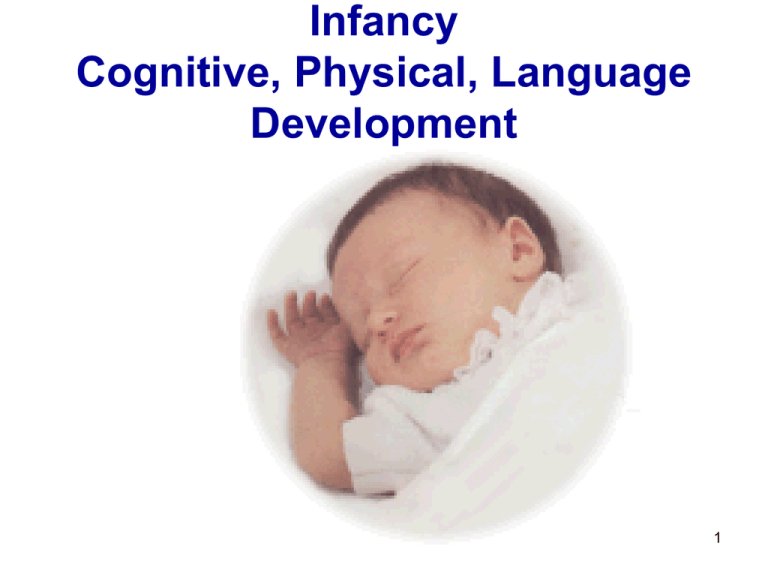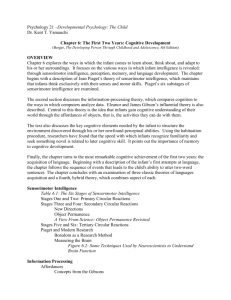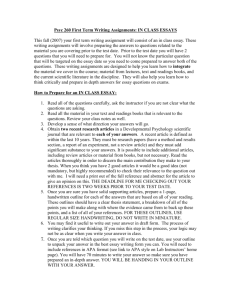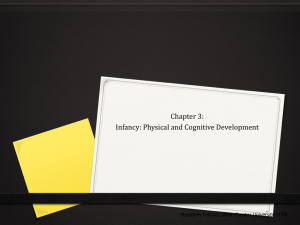Infancy Cognitive, Physical, Language Development
advertisement

Infancy Cognitive, Physical, Language Development 1 2 Neonates • States of Arousal • Reflexes • Neonatal Assessment • Learning and Habituation 3 States of Arousal Peter Wolff (1966) • • • • • • Waking activity Crying Alert inactivity Drowsiness Regular sleep Irregular sleep 4 Survival Reflexes • • • • • Breathing Rooting Sucking Pupillary Eye-blink 5 Primitive Reflexes • • • • • • • Moro (startle) Palmar Plantar Babinski Stepping Swimming Tonic neck 6 Swimming Startle (Moro) 7 Tonic Neck 8 Babinski 9 Plantar 10 Stepping Palmar 11 Brazelton’s Neonatal Behavioral Assessment Scale (BNBAS) • An assessment measure that hospitals use the first few days of a baby’s life. • 28 measures are grouped into 7 clusters • Includes – Neurological examination – Assessment of social responsiveness – Assessment of behavioral capabilities 12 Clusters of Brazelton’s Neonatal Behavioral Assessment Scale • • • • • • • Habituation Orientation Motor tone and activity Range of State Regulation of state Autonomic stability Reflexes 13 14 Habituation and Learning Habituation Method • To study infant perceptual abilities, researchers habituate infants to certain stimuli and then change the stimuli. • Examples – Habituating neonates to turn their heads to the left to obtain milk whenever a bell was rung – Neonates learned to turn on a light by turning their heads to the left. 15 Erich Fromm Man is the only animal that can be bored 16 Physical and Motor Development • Erik Erikson • First Psychosocial Stage Trust vs. Mistrust 17 First 4 Months doubled in weight eyes have begun to focus the 1st tooth is about to erupt most reflexes have disappeared From 5 to Eight Months increasing competence in fine and gross motor skills playing games crawling, bearwalking, scooting 18 From 9 to 12 Months about three times heavier than they were at birth may be walking can manipulate the environment using a pincer grasp From 13 to 18 Months are walking on their own can stack blocks can feed themselves May be able to undress partially 19 From 19 to 24 Months are called toddlers can pedal a tricycle can jump in place can climb stairs can scribble can dress and undress without assistance 20 21 Sensory and Perceptual Development • Sensation The translation of a stimulus by a sense organ • Perception The complex process by which the mind interprets and gives meaning to sensory information 22 Studying Infant Perceptual Capabilities • The novelty Paradigm Closely related to habituation method • The Preference Method Gives a choice of stimuli to look at or listen to • The Surprise Method Relies on the fact that infants react with surprise when their expectations are violated • Event-Related Potential Method Provides the equivalent of a complex electroencephalograph 23 Vision and Visual Perception • Infants are born with a full intact set of visual structures. • Newborns’ eyes are sensitive to brightness • They have some control over eye movement • Newborns focus optimally on objects at a range of 7 to 10 inches • They look primarily at the edges and contours of objects • Are responsive to human face and are able to imitate facial expressions • By the first 4 to 6 months, infants can focus almost as well as adults, acuity sharpens, and they can discriminate between most colors 24 Visual Cliff 25 Depth and Distance Perception • Because the newborn eyes are not well coordinated and the infant has not yet learned to interpret all of the information transmitted by the eyes. • Early depth perception is probably not very sophisticated. • Even when coaxed by their mothers, infants 6 months or over will not crawl over the edge of the visual cliff. 26 Auditory Perception • Neonates can hear. They are startled by loud sounds • Newborns are soothed by low-pitched sounds such as lullabies • Infants seem able to localize sounds, and prefer human voices 27 Taste, Touch, and Smell • They are fully operating at birth, and the sense of touch is well developed. 28 Sensory Integration and Intermodal Perception • Research generally indicates that either the senses are integrated at birth or integration occurs early and rapidly. • Behavior and emotion become integrated over time as a result of the interaction of experience and maturation 29 Cognitive Development • The Active Mind Infants take an active role in their cognitive development. This was the basic position of Jean Piaget. Infants possess mental structures called schemes that process and organize information. This occurs in a series of stages. 30 Jean Piaget 31 Jean Piaget 1- Knowledge = motor behavior 2- Universal stages in a fixed order 3- Qualitative and quantitative acquisition of knowledge 4- Mental Structures or schemes 5- Two Principles: Assimilation Accommodation 32 1- Acquisition of Knowledge • Action = Knowledge • Infants attain understanding of the world by doing. • Knowledge is a product of direct motor behavior • Children don’t learn: – Through sensation and perception – From facts communicated by others 33 2- Piaget’s Stages of Cognitive Development • Sensorimotor Stage (birth – 2) • Preoperational Stage (2 – 7) • Concrete Stage (7 – 11) • Formal Operations Stage (12 – adulthood) 34 Piaget’s Cognitive Stages 35 Sensorimotor Stage Substages 1- Simple Reflexes (first month) Reflexes determine the infant’s interaction with world 2- First Habits & Primary Circular Reactions (1 – 4 months) Coordination of actions Repeating enjoyable actions on the infant’s own body 36 Sensorimotor Stage Substages 3- Secondary Circular Reactions (4 – 8) Repeated actions meant to bring about desirable consequence on the outside world 37 Sensorimotor Stage Substages 4- Coordination of Secondary Circular Reactions (8 – 12) Goal Directed Behavior Several schemes are combined and coordinated to generate a single act to solve a problem Object Permanence The realization that people and objects exist even when they cannot be seen 38 Object Permenence 39 Sensorimotor Stage Substages 5- Tertiary Circular Reactions (12 – 18) The deliberate variation of actions to bring desirable consequences 6- Beginning of Thought (18 – 24) Symbolic Representation The use of a word, picture, gesture or other sign to represent past & present events, experiences, and concepts. a. Understanding Causality b. Deferred Imitation 40 3- Quality and Quantity • Until the 1930s, children were considered like miniature adults as far as intelligence was concerned. • They were supposed to differ from adults in the quantity of knowledge they had managed to acquire. • According to Piaget, children acquire knowledge in a qualitative and quantitative manner. 41 Constructivism • All we know is based on our mental construction or ideas. • We don’t passively discover knowledge ready-made. • We actively construct knowledge. How? 42 4- Schemes/Mental Structures • Infants have mental structures or schemes: (organized patterns of sensorimotor functioning) Sensorimotor Functioning Physical activity that changes with mental development 43 5- Principles for Children’s Schemes • 1- Assimilation • 2- Accommodation 44 5- Principles for Children’s Schemes 1- Assimilation is when people understand an experience in terms of their current stage of cognitive development or way of thinking. Example: A flying squirrel = a bird The child is assimilating his existing scheme of a bird. 45 5- Principles for Children’s Schemes 2- Accommodation is change in existing ways of thinking that occur in response to encounters with new stimuli or events. Example: A flying squirrel = a bird with a tail The child is accommodating to new knowledge, modifying her scheme of “bird” 46 Criticism on Piaget’s Theory • Piaget constructed his view by mainly observing his three children (not a representative population) • A stable and differentiated perceptual world is established much earlier in infancy than Piaget envisioned • Memory and other forms of symbolic activity occur by at least the second half of the first year. 47 Memory in Infancy Infants as young as 3 months old show memory skills. • The Large Black Boxes Study Infants predicted a four-step sequence and most could remember it up to 2 weeks later. • Carolyn Rovee-Collier Infants can remember intricate material. • Nancy Myers An infant’s experience at 6 months can be remembered 2 years later. 48 Infants’ Memory • Infantile Amnesia The lack of memory for experiences that occurred prior to three years of age Although memories are stored from early infancy, they cannot be easily retrieved. Early memories are susceptible to interference from later events. Memories are sensitive to environmental context. 49 Infants’ Intelligence 1- Development Quotient Arnold Gesell 2- Bayley Scales of Infant Development Nancy Bayley Are useful in identifying infants who are significantly behind their peers Are not good for predicting future behavior 50 Development Quotient Arnold Gesell • An overall developmental score that relates to performance in 4 areas: 1- Motor Skills (balance and sitting) 2- Language Use 3- Adaptive Behavior (alertness & exploration) 4- Personal-Social (feeding and dressing) 51 Bayley’s Scales of Infant Development Nancy Bayley • A measure that evaluates an infant’s development from 2 to 3 months • It focuses on 2 areas: 1- Mental Scale Senses, perception, memory, learning, problem solving, language 2- Motor Scale Gross motor skills Fine motor skills 52 Contemporary Approaches to Assess Infant Intelligence • Visual-recognition Memory • Cross-modal Transference Measure how quickly infants process information These measures correlate moderately well with later measures of intelligence 53 Visual-Recognition Memory Measures how quickly an infant can retrieve previous experiences of a stimulus from memory 1- Measures how quickly infants lose interest in stimuli that have already been seen 2- Measures their responsiveness to new stimuli. 54 Cross-Modal Transference • Measures the ability to identify a stimulus that has previously only been experienced through one sense by using another sense. Example Identifying a screw driver that she has only previously touched, but not seen 55 Other Criteria in Determining Adult Intelligence • The degree of environmental stimulation • Intelligence measured by IQ tests relates to a particular type of intelligence, one that emphasizes abilities that lead to academic success but not artistic or professional success. • So, predicting that a child will do well on IQ tests does not necessarily indicate success in life. 56 Linguistic Competence Phonemes Basic sounds of language Morphemes words, suffixes, prefixes Semantics Rules that govern the meaning of words Syntax How words are combined into meaningful statements Pragmatics The use of language in context 57 12 weeks cooing, smiles when talked to 16 weeks turns head in response to human voice 20 weeks makes vowels and consonant sounds 6 months babbling (all sounds) 8 months repeat certain syllables (ma-ma) 12 months understands and says some words 18 months can produce up to 50 words 24 months more than 50 words, two-word phrases 30 months about 100 words, phrases of 3-5 words 36 months vocabulary of about 1,000 words 48 months most basic aspects of language are well established 58 Terms Holographic Speech the use of single words to convey complete thoughts Overextensions the tendency to overgeneralize words Telegraphic Speech omitting the less significant words and including the words that carry the most meaning Pivot Grammar action words + nouns (see Daddy) 59 A Different Language for Boys and Girls • Girls Hear twice as many diminutives Parents respond with a soft answer Are exposed to warmer phrases • Boys • Don’t hear as many diminutives • Parents respond with a firm “no” • Hear clearer language • As adults they tend to be more assertive 60 Language Acquisition Cognitive Piaget -Mental schemes that child can apply a linguistic label to it Rationalist Chomsky Social Learning -Innate -learned tendency to -imitation acquire language -Innate acquisition device Behaviorist Skinner -Acquired by consequences or by reinforcement 61 Information Processing Approaches • Encoding Recorded in memory (Keyboard) • Storage Saved in memory (on hard drive) • Retrieved Brought into awareness (on screen) 62 Information-Processing Automatization 1- Knowledge acquisition is automatic when processes require little attention Children are automatically aware of how often they have encountered people. Automatically, children develop an understanding of concepts, categorizations of objects, events, or people. 2- Knowledge is deliberate and controlled when processes require large amounts of attention. 63 Information Processing Approaches Cognitive Architecture Determines the specific steps through which material is processed as it travels through the human mind. Assume that the basic architecture of information-processing systems is constant over the course of development, although the speed and capacity of the system are thought to grow. 64 Prelinguistic Communication 2 – 3 months to 1 yr. 10 – 14 months 15 months 16 – 24 months 18 months 19 months babbling holophrases 15 words 100 words telegraphic speech first sentence 65








